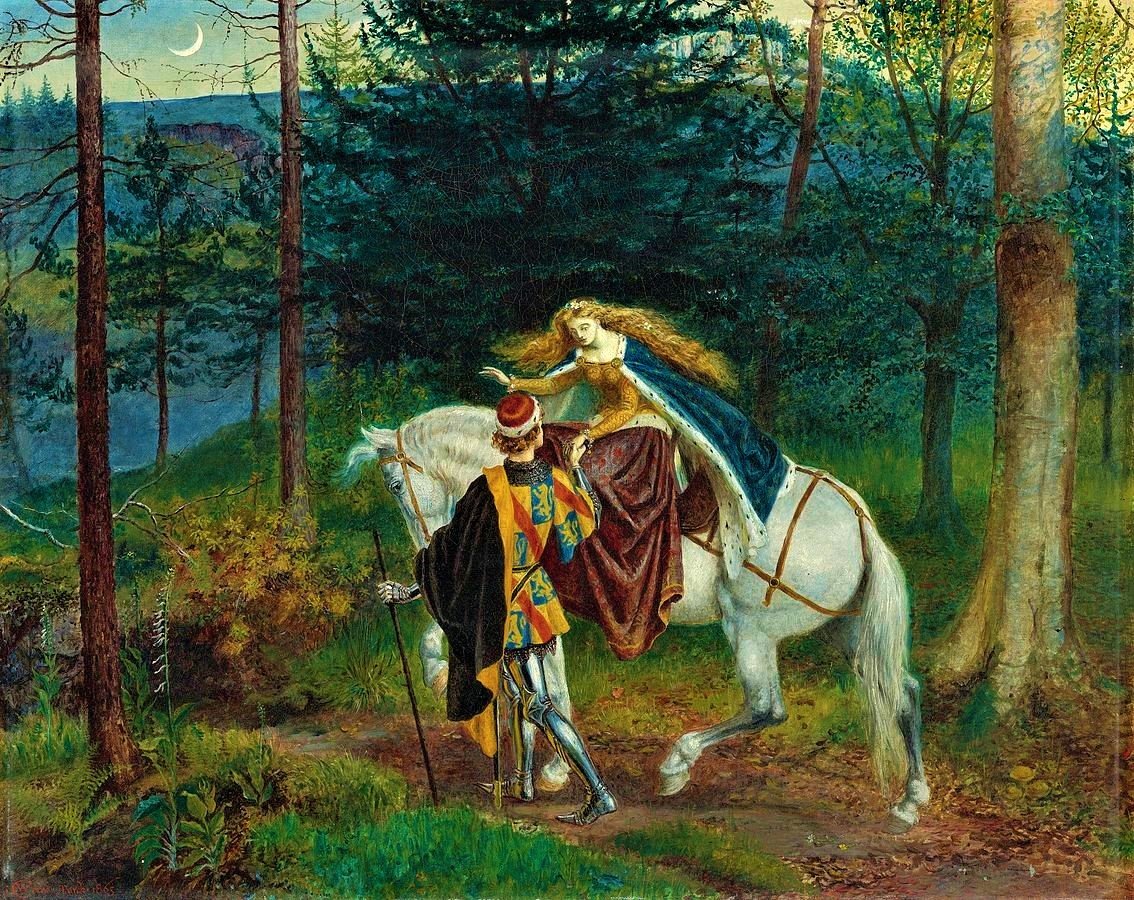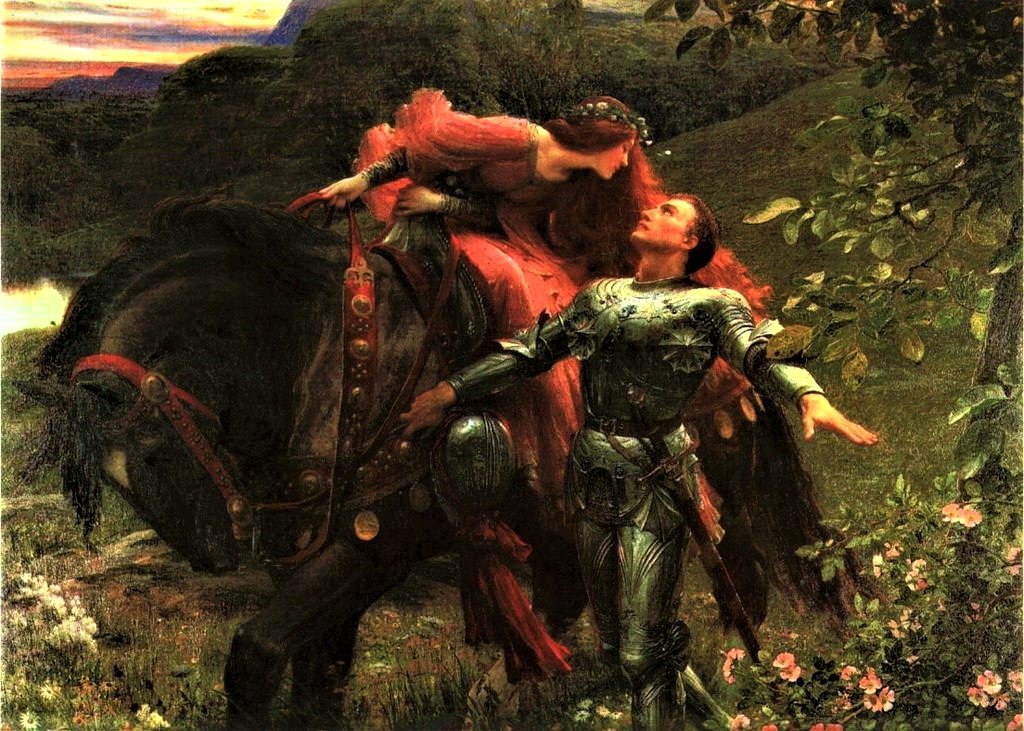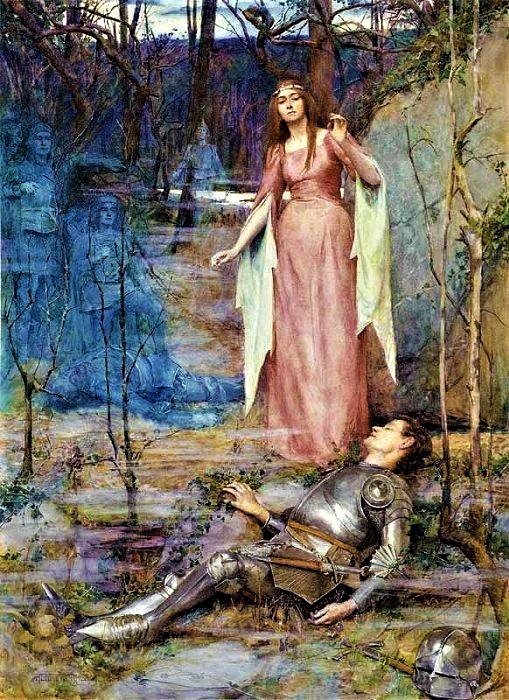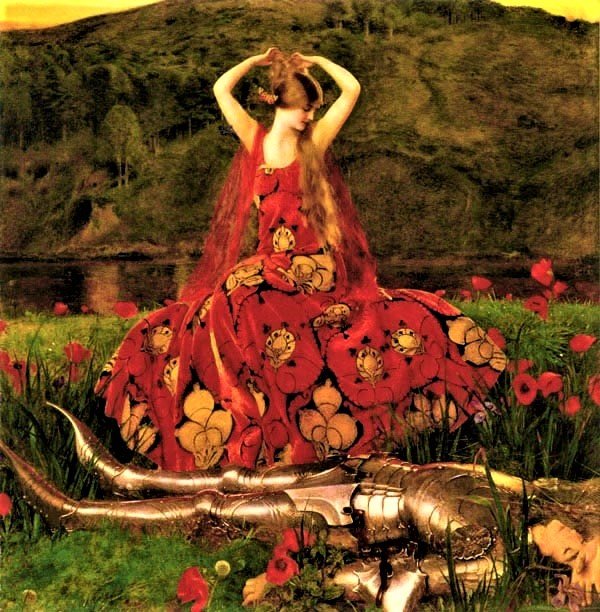“A 19th-century influence of Gothic Faerie: The fairy tree, fairy lover, fairy art, and fairy revenge in Clay Franklin Johnson’s poem ‘A Ride Through Faerie’”
‘In faery lands forlorn’:
Celtic and Keatsian Influences in ‘A Ride Through Faerie’
I am truly honored to have an essay about my poem “A Ride Through Faerie” published in Gramarye, the journal of the Chichester Centre for Fairy Tales, Fantasy and Speculative Fiction from the University of Chichester. To have my poem understood and written about in such an academic way, comparing particularly inspired lines and themes with John Keats, my beloved poet of poets, means more to me than I can express in words. You can find this special issue of Gramarye on the University of Chichester’s website here.
The essay first began life as a paper presented at “Ill met by moonlight”: Gothic encounters with enchantment and the Faerie realms in literature and culture in April of 2021, a conference organized by the Open Graves, Open Minds Project (OGOM) with the University of Hertfordshire that discussed the darker side of faeries in literature. The conference was a glamourous affair, brilliantly organized, the topics were fascinating and true obsessions of mine, and I was delighted to have my writing included. I want to take a moment to thank everyone involved in “Ill met by moonlight”, including Professors Sam George and Bill Hughes who are the guest editors of this Gothic Faerie issue of Gramarye.
Here are four stills from the presentation discussing my poem. I am including slides that juxtapose hallucinatory lines with the art of John Anster Fitzgerald, known most fittingly as “Fairy Fitzgerald”, a favorite artist whose wondrously nightmarish faery paintings influenced my poem’s opium-fueled dream vision in Part III’s Fragment of a Dream. “Fairy Fitzgerald’s” work has fascinated me for many years, and not only did his work inspire lines of opium-soaked fancy and illusory within my poem in question, The Artist’s Dream (c. 1860) and The Fairies’ Banquet (1859) most especially, but his paintings have also influenced a myriad of other writings tinctured with that same sort of alchemy and liquid enchantment.
True to the title of the essay, “A Ride Through Faerie” was absolutely written with the concept of Gothic Faerie in mind, which can be thought of as the dark side of Fairyland. Perhaps unknown to most, the realm of Faerie was once considered a deathly Otherworld of sorts, a place of creeping dread meant to be feared, not the alluring lands of glamourie and enchantment to romanticize about, and the faeries that inhabited this world were thought of as vengeful undead, fallen angels, and even as vampiric demons of pure malevolence lusting for human blood — far from the twee little Disneyfied things that most people associate faeries with today. This rather forgotten idea of the dark side of faeries, especially concerning the fatal vengefulness brought on by the destruction of sacred woodland, is at the very heart of my poem.
I wrote “A Ride Through Faerie” rather quickly while under a spell of what can be called “inspired rage” in August of 2019. This inexorable form of inspiration emerged out of the flames of ecocide that occurred during the 2019 Amazon Rainforest Wildfires, when precious rainforest, the “sacred woodland” to the Amazon’s fairylike flora and fauna, was being consumed by man-made deforestation. This murderous rape of the rainforest and all its beautiful life was driven by greed and man’s mercenary desire for greater profits. As I reflect upon this almost four years later, and knowing that the situation in the Amazon and elsewhere in the world has only worsened, it is no wonder why I felt compelled to write about this fantastical form of justice called Faerie Revenge. I wrote more about this inspired rage that led to my poem in a narrative essay for the 200th anniversary of Keats’s 13 October 1819 letter to Fanny Brawne here.
However, although my poem was written more in the tendrilled vein of ecoGothic at the time of composition, its associations with Gothic Faerie are rooted deep. In Gaelic folklore, especially the wondrous collection of myths belonging to the Celtic peoples of Ireland and Scotland, the solitary hawthorn tree is understood to represent the doorway into the otherworld. The hawthorn (Sceach Gheal in Irish, and Sgìtheach in Scottish Gaelic), also known as the Faery Tree, has a rather particularly strong connection to faeries including the Faerie Queen herself, and this connection is fundamental to the understanding of my poem. There are several sources about the folklore of the hawthorn that inspired me, but one in particular was the legend of Thomas the Rhymer, a Scottish poet of the thirteenth century who “met the Faery Queen by a hawthorn” and from there “led him into the Faery Underworld for a brief sojourn.” Upon his reemergence from this faery underworld, or Faerie, Thomas finds that he has been gone for a number of years, which is a recurrent theme in Celtic mythology, and one I used in my own poem.
It is possible that John Keats read the ballad of Thomas the Rhymer in translation, or “Englished”, and had it in mind when he wrote his own ballad “La Belle Dame sans Merci” in 1819. There is a passage that I first found in Professor Earl R. Wasserman’s The Finer Tone: Keats’s Major Poems (1953) that works wonderfully well in pointing out the similarities between Rhymer’s and Keats’s poems, and even my own. In a rather strange coincidence, as it so often happens, I recently reread Wasserman’s passage in Professor Susan Stewart’s Poetry and the Fate of the Senses (2001), which has an interesting section discussing Keats’s “La Belle Dame” and the poem’s possible influences, including the legend of Thomas the Rhymer. I will write out Wasserman’s passage below along with the similarities shared between Keats’s poem and my own written within brackets.
Whatever the specific source may have been, the narrative [of Keats’s “La Belle Dame sans Merci”] clearly belongs to a folk legend best known in the form of the mediaeval ballad, “Thomas Rymer.” In the version available to Keats in Robert Jamieson’s Popular Ballads 1806, Thomas encounters a beautiful lady [the beautiful “green-eyed Setareh” in my poem] … who identifies herself as “the queen of fair Elfland” [The Faerie Queen]. She takes him upon her milk-white steed [“A pale horse, silvered by dawn’s early rays, / Unbridled and with eyes of spectral emerald” in my poem] … and for forty days and nights they ride through blood while Thomas sees neither sun nor moon [“I set her on my pacing steed, / And nothing else saw all day long” in Keats’s “La Belle Dame”]. … At length they rest before a hill [“And there she lullèd me asleep, / And there I dreamed… / On the cold hill’s side” in Keats’s “La Bella Dame”], and the elf-queen, placing his head on her knee, shows him three wonders [the Faerie Queen in my poem gives Lord Ortho (the tree-killing antagonist) a “glowing cup of tea” which shows him “dreams poetical / And visions phantasmal”] … and for seven years “True Thomas on earth was never seen” [In my poem, Lord Ortho, “before he withers away to bone-dust”, has been away for two hundred years, although his ride through Faerie was only for “a single solitary day”].
And while it is impossible to know for certain if Keats read or even knew about the legend of Thomas the Rhymer (it is never mentioned in his letters or writings), “La Belle Dame sans Merci” has influenced my own writing in profound ways over the years — “A Ride Through Faerie” perhaps most of all. And not only has Keats’s poem inspired me with Elfin images of “wild wild eyes” and music of “a faery’s song”, but so have the myriad of brilliant artworks that exist only because of this Keatsian inspiration. To name but a handful of artists whose works I adore, there is Walter Crane, who also painted most poignantly the graves of Keats and Shelley, John William Waterhouse, Frank Dicksee (Sir Francis Bernard Dicksee), Henry Meynell Rheam, and Frank Cadogan Cowper.





The idea of the femme fatale, principally as an enchantress with powers of glamourie and spell-craft, holds a particular fascination for me and appears often in my writing. However, unlike the archetypal misogynistic trope of the wicked seductress, or “deadly woman” commonly portrayed in literature and art as the antagonist who corrupts the hero with the depravity of unbridled female sexuality (I used a Keatsian sort of pun on the word “unbridled” in my poem), the femme fatale in my writing is always the protagonist who represents a supernatural sort of enchantment, possessing an otherworldly intelligence, Gothic and dark, but also quite confidently owning the commonly used traits as being both beautiful and mysterious — a Byronic Heroine of sorts, to be sure.
The femme fatale in my poem, or rather the heroine, is “The Fated Star,” the one “who walks in starlight, / Not in beauty, but in cold philosophy,” whom I named Setareh (Persian: سِتاره) which means “star” or “fate” in Persian. Her name I derived from Sir Philip Sidney’s Astrophil and Stella, a sonnet sequence written in the 1580s, parts of which I had to memorize at university. Astrophil (or Astrophel) comes from two Greek words, “aster” (star) and “phil” (lover), while “stella” derives from Latin meaning star. Not only does Setareh, or “The Fated Star,” represent the Faerie Queen in my poem, but she is also the personification of Nature herself. I have been inspired by this theme in other poems of mine, including “From Shadow to Light”, “The Fires of Ecstasy at Samhuinn”, “Finding Hecate”, “Ode to a Night Flower”, and “My Mélusine Illusion”.
The latter poem holds a special place in my heart which, not surprising given the title, is a somewhat personal narrative poem based on the folklore of the faery Mélusine whom I have a deep fascination with. The Melusinean seeds of inspiration were planted after witnessing (or imagining) a Shelleyan sea-vision floating upon the enchanted waters of the Cantabrian Sea while I was staying in Asturias in 2018, on the very same white sands in Llanes where my beloved Rowing with the Wind (1988) was filmed thirty years earlier — Isla Castro de Ballota appeared to me more like Claude Lorrain’s Enchanted Castle floating in the near distance. Inspired moments such as these are marvelous, unforgettable, almost otherworldly, and as my dear Mary Wollstonecraft wrote in her personal travel narrative Letters Written During a Short Residence in Sweden, Norway, and Denmark (1796), “Eternity is in these moments. Worldly cares melt into the airy stuff that dreams are made of.”
Several pages of obscure esoterica were scribbled down — puzzling even to me — as I brooded upon this faery-vision. Bewitched by illusion my mind was mesmerized with fantasy, and as I gazed out toward the enchanted sea, hoping to glance one more fancy of the imagination, or even a spectral Fata Morgana floating on the distant horizon, I could not help but feel a deep sort of peace. I was alone, inspired, and wonderfully at home in solitude upon these Asturian sands.
The last italicized phrase in the above paragraph is meant to be a reverential and somewhat homophonous nod to Julian Sands, a favorite actor of mine who went missing in the San Gabriel mountains on 13 January this year. Julian played a marvelously mad “mad Shelley” in Ken Russell’s Gothic (1986), a brilliantly mad film that I watch every June as a prelude to my “haunted summer” inspirations — copious amounts of proper absinthe are had on these nights, and a special toast will be given to Julian this coming June. The film was inspired by “ghost-stories” and “nightmares” that occurred at Villa Diodati during the Year Without a Summer of 1816, a long-held obsession of mine, as well as a screenplay written by Stephen Volk. Both the historical truths of this obsession and the opium-rich madness of the film, which Julian said “portrays Lord Byron as demonic and Shelley as on the verge of madness, but the film is an expressionist piece, and that's not an unreasonable expression of their realities”, inspired one of my first-published poems, “Ghosts of 1816”, which, quite fittingly, I finished while at Villa Diodati on the 200th anniversary of this haunted summer madness in June 2016. Sadly, and somewhat strangely related, Ronan Vibert, the actor who played Fletcher in Rowing with the Wind and filmed scenes on the very Asturian sands that I am writing about, died less than a month earlier on 22 December 2022 at the age of 58.
However, not long after leaving Asturias, the so-called “worldly cares” came back to me in full and all abstract ideas of a poem composed on the subject of the faery Mélusine were lost. Such cares were made almost unendurable weeks later in England where I found nothing but regret, heartbreak, and a deep lingering grief that haunted me for the entirety of my winter in Scotland. It was the loss of my dear little basset hound Anna, who died back home in the US on the very same day I was wandering the gardens of Newstead Abbey, Byron’s ancestral home, that left me broken and heartsick with grief. It was poignantly uncanny, for the foremost reason of my going was to pay homage at Boatswain’s Tomb (the monument to Byron’s beloved dog) in honor of my beloved chocolate lab Blue who had died just a year prior — the grief of Blue’s death was still deeply felt at this time. To have lost my dear Anna on the very day of this tribute to Blue is an experience I will never forget.
This is a detail from the third and final illustration to my poem “Lines Written by Moonlight at Whitby Abbey” that honors both my Blue and Anna — these are actual photographs of my beloved pooches incorporated into the illustration, and behind them is Boatswain’s Tomb, complete with “Epitaph to a Dog”.
It wasn’t until the spring of 2021, a few months after the heartbreaking bicentenary of Keats’s death on 23 February when I spent all day and night writing “Keats Stone” in his honor, when these Melusinean visions of inspiration returned. I had just finished a proper re-reading of A.S. Byatt’s Possession: A Romance (1990), a favorite novel that concerns two literature-loving academics who obsess over the lives and love-letters between two long-dead poets, a trip to Whitby which leads to a discovery of “Whitbyan jet”, and, yes, even an epic poem based on the legend of Mélusine. This no doubt reawakened those long-lost memories of Asturian seas “in faery lands forlorn”, the phantasmal beauty of that spectral sea-vision appeared once more within my mind’s eye, and I spent the rest of the year consumed with writing the piece that would become “My Mélusine Illusion”.
The poem, which, beyond the stanzas of hallucinatory madness (Coleridgean, in spirit) and literary elements of folklore and legend, is essentially a metaphysical retelling of the faery Mélusine’s story, written from a more feminist perspective. The Mélusine in my poem is the femme fatale of glamourie and spell-craft that I wrote about above, she is the star, the luminary, the goddess divine, and, of course, the heroine that one inspires to be — perhaps quite literally in the closing lines. Olivia Claire Louise Newman writes a bit about the feminist aspect in her wonderful essay “The Duality of Light and Dark in Otherworlds as Explored in Clay Franklin Johnson’s ‘My Mélusine Illusion’”, published in 2022 within the Other-Than-Human Realms issue of Eternal Haunted Summer. I am both honored and thankful to have yet another lovely essay written about one of my poems, and a poem that has such significant meaning to me. You can read Olivia’s essay here.
Returning to the femme fatale in “A Ride Through Faerie”, or the “green-eyed” heroine known as Setareh, the essay published in Gramarye discusses her in detail, focusing significantly on the Keatsian influence. Therefore, instead of writing about how Keats’s poetry helped shape my own vision of the femme fatale, not only in “La Belle Dame sans Merci” but also within the Ovidian witchery of his brilliant “Lamia” (1820), I will just post a couple of slides from the Gothic Faerie conference organized by Open Graves, Open Minds with the University of Hertfordshire.
There is, however, one last influence related to both Keats and the concept of Gothic Faerie that I must mention, if but only briefly. I want to write about how I came up with the name of my antagonist, Lord Ortho — this is not discussed in the essay published in Gramarye and it holds an interesting significance. Firstly, I will begin with Sir Orfeo, an anonymous Middle English chivalric romance, or Breton lai, that was most likely written in the late 13th or early 14th century. Without going into excessive detail, the most essential elements of the plot that are relevant revolve around an English king, Sir Orfeo, who leaves his earthly kingdom to travel to the realm of Faerie in order to save his wife Heurodis from the Faerie King. In my poem, Lord Ortho too must travel to the realm of Faerie in order to save his wife Setareh, but, in a simple twist to this Celtic motif of faery abduction, Setareh is in fact the Faerie Queen herself and has thus deceived Ortho because of his treachery in the destruction of her sacred faery tree.
Apart from the poem’s Celtic influences in narrative and elements of faery-lore, not to mention Tochmarc Étaíne (The Wooing of Étaín), an early text of the Irish Mythological Cycle and most probable source text, Sir Orfeo is a retelling of the Greek myth of Orpheus written in an English context — the name of Orfeo is Italian for Orpheus, after all. Although there are variations, the ancient Greek myth concerns Orpheus, a great poet and musician of Thrace (Traciens in Sir Orfeo), who must descend into the Underworld (the realm of Faerie in Sir Orfeo) to recover his beloved dead wife Eurydice (Heurodis in Sir Orfeo) from Hades, the king of the dead in this deathly underworld (the Faerie King in Sir Orfeo). In order to rescue Eurydice, Orpheus plays his lyre for Hades, and, not surprisingly, Orfeo plays his harp for the Faerie King to save Heurodis. Both are successful with their musical abilities, but the chief difference — besides the marvelous Celticization and bits of faery-lore — is that the Greek myth of Orpheus ends in tragedy, whereas Sir Orfeo ends happily.
There is a lovely modern translation of Sir Orfeo by J.R.R. Tolkien published in his translations of both Sir Gawain and the Green Knight, one of the most well-known poems of Arthurian legend, and Pearl, a wondrous dream vision poem with themes of death and transience. Interestingly, scholars believe the author of these two works to be one and the same, nicknaming the anonymous author the “Gawain Poet”, or, less frequently, the “Pearl Poet”.
As it pertains to Keats and the inspiration behind the name of Lord Ortho, I dare say that the explanation is far simpler. In July and August of 1819, exactly two hundred years to the month when I began “A Ride Through Faerie”, Keats was writing his tragedy Otho the Great, a drama that he hoped would be staged at Drury Lane, and, with his beloved Fanny Brawne in mind, a piece that would become a financial success. Keats had pinned all monetary hopes on the idea that Edmund Kean, the great Shakespearean actor of the day, would play the starring role of Ludolph. Even Samuel Taylor Coleridge, another beloved poet of mine, wrote of Kean’s dramatic brilliance, writing that “to see him act was like reading Shakespeare by flashes of lightning”.
Unfortunately, success was never to find Keats during his lifetime. Although Keats began writing Otho the Great while on the Isle of Wight in July of 1819, finishing it some weeks later in August within the “Town quietude” of Winchester, the piece would not be published until 1848, twenty-seven years after his death. In fact, Otho would remain mostly forgotten for over a century, receiving its first stage performance at St. Martin’s Theatre in 1950. My antagonist’s name of Lord Ortho, from the Greek prefix ortho- meaning “upright” and “right” (but used with a more pejorative connotation, in an uptight, pretentious know-it-all sort of way), is quite simply a nod to both Keats’s Otho the Great on its anniversary and the Middle English lai of Sir Orfeo, including its Celtic themes.
In closing, I just want to take a moment to thank all involved in the Gothic Faerie issue of Gramarye, including the Chichester Centre for Fairy Tales, Fantasy and Speculative Fiction; the University of Chichester; Heather Robbins, administrator with the Chichester Centre, who kindly helped me order several copies without overpaying for international shipping; and Tatiana Fajardo, PhD student at the University of the Basque Country, for finding my poem interesting enough to write about, as well as for reaching out to me to inquire about the more obscure and enigmatic references within my writing, particularly the nightmarish paintings of Fairy Fitzgerald that influenced my poem’s opium-inspired dream vision, and, most especially, the many influences of John Keats (a topic that I love to talk about). I also want to thank everyone involved in the Gothic Faerie conference “Ill met by moonlight”, including Open Graves, Open Minds (OGOM); the University of Hertfordshire; and Professors Sam George and Bill Hughes, the guest editors of this special issue of Gramarye.
As I mentioned in the very first paragraph of this longer-than-expected piece, you can find the Gothic Faerie issue of Gramarye on the University of Chichester’s website here.






